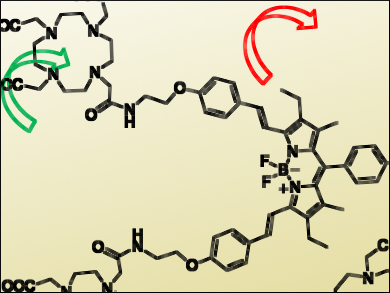The search for new and improved monomolecular imaging probes for medical purposes is a hot research topic. There are many different imaging techniques that are used to “see” in vitro, such as positron emission spectroscopy (PET) and single-photon emission computed tomography (SPECT). Thus, there are many different tracers and fluorescent agents, each with their own use, and all must function to a high standard.
One challenge in this area is finding one compound that is effective for use in a multitude of techniques. This could improve therapeutic outcomes by enabling more efficient pre-, inter-, and postoperative scanning. In most cases, the target (e.g., an antibody or peptide) is radiolabeled and fluorescence-labeled sequentially, with no balance of radio/fluorescence labels.
Christine Goze, Frank Denat, Université Bourgogne Franche-Comté, Dijon, France, and colleagues have developed a MOMIP – a mononuclear multimodal imaging probe. This is one molecule that has the capability of providing near-infrared (NIR) fluorescence as well as heavy metal chelation in vivo. The fluorescent marker is a BODIPY (boron-dipyrromethene) derivative. BODIPYs are well-known for stable and good photophysical properties. Linked to th BODIPY derivate are three DOTA macrocycles(1,4,7,10-tetraazocyclododecane-1,4,7,10-tetraacetic acid). These not only compensate the lipophilicity of the BODIPY core, but act to minimize aggregation and facilitate radiolabeling with radioisotopes such as indium-111.
This multifunctional probe is stable in serum and shows good accumulation onto tumor sites for effective fluorescent imaging. These properties, confirmed by tests on tumors in mice, show the compounds potential for use as a bimodal imaging probe.
- Near-Infrared-Emitting BODIPY-trisDOTA111In as a Monomolecular Multifunctional Imaging Probe: From Synthesis to In Vivo Investigations,
Nicolas Maindron, Martin Ipuy, Claire Bernhard, Damien Lhenry, Mathieu Moreau, Sabin Carme, Alexandra Oudot, Bertrand Collin, Jean-Marc Vrigneaud, Peggy Provent, François Brunotte, Franck Denat, Christine Goze,
Chem. Eur. J. 2016.
DOI: 10.1002/chem.201602886




